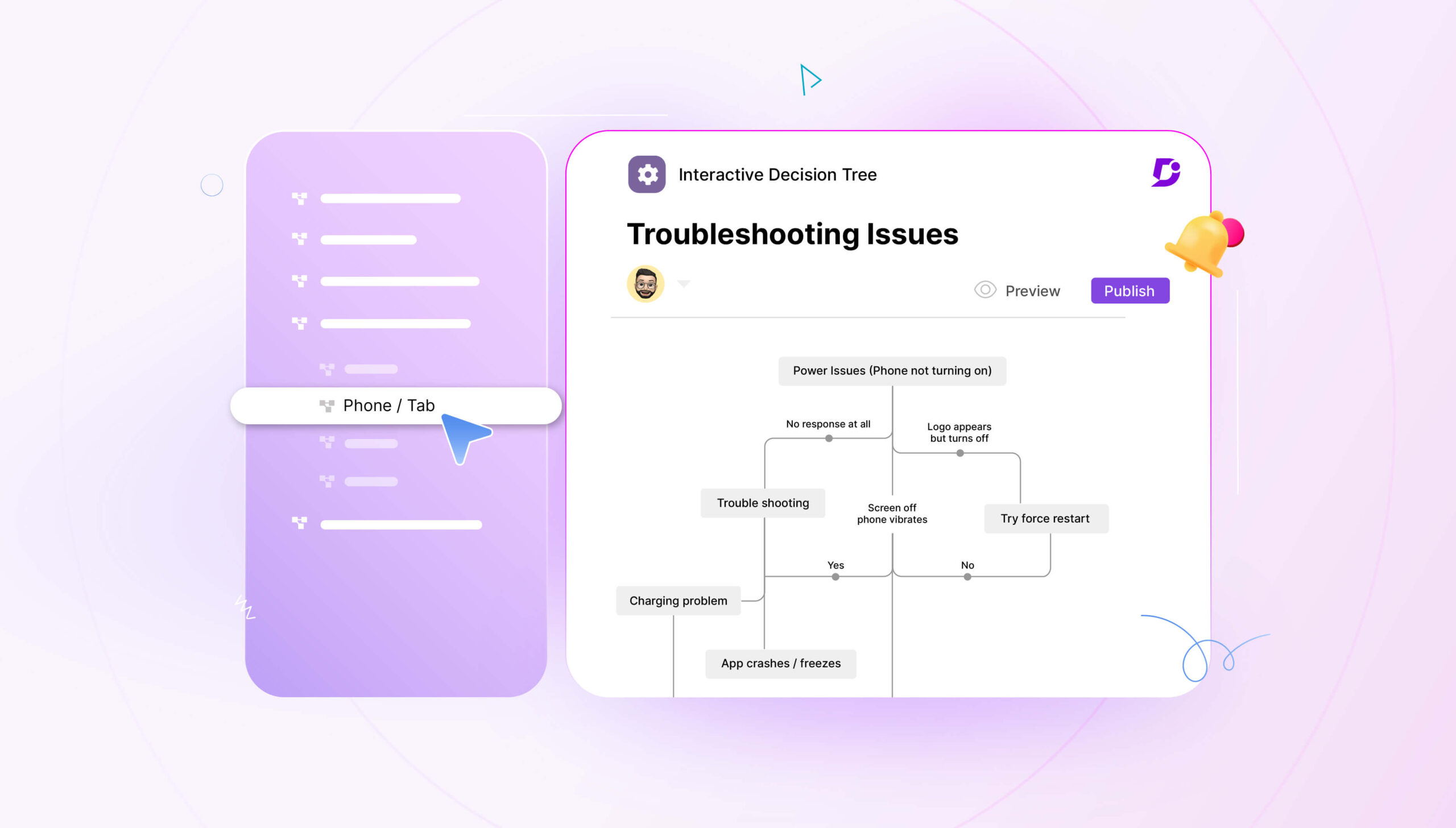Clients who receive excellent customer support are four times more likely to be loyal to a brand than those who are poorly treated.
Every positive experience you offer your customers generates new opportunities and helps you build long-term business relationships while increasing customer retention.
As part of your customer support strategy, your knowledge base should be a top priority and involve more than one department inside the company.
An efficient knowledge base content strategy is the result of collaboration between your marketing, sales, and customer support teams.
By working together, you can create intuitive content that meets your clients’ needs and stays in line with your marketing strategy.
6 Essential Steps to Build Knowledge Base Content Strategy
Step 1: Know your audience

Just as you build buyer personas for content marketing, you need to identify customer personas to create a knowledge base content strategy.
This approach allows you to learn as much as possible about the target audience of your knowledge base—your clients.
Building customer personas is easier than creating buyer personas since you don’t have to make suppositions about who your public is.
The people who read the articles in your knowledge base are the customers who have bought your product and use it for personal or professional purposes.
31% of customers want instant online help. Get started with a knowledge base solution
Signup now
To build your personas, find accurate data about your customers, including:
Demographics
- Age
- Location
- Education
- Company size
Professional History
- Position inside the company
- How often they interact with your product
- How familiar they are with your software
Expectations
- What motivated them to buy your product
- Their needs regarding your product
- How these needs change over time
To gather all this data, your marketing and sales people need to work together.
When you know your audience well, you can craft better knowledge base articles, based on pain points and topics of interest for your customers.
The more you know about your target public, the higher your chances of providing your knowledge base readers with an excellent customer experience.
They can find all the information they need directly on your website–which means fewer calls and tickets to solve.
Also read: Strategic Approach to Use Knowledge Base as Marketing Tool (5 Simple Steps)
Step 2: Understand how customers use your product to build the right knowledge base content strategy

Once you have a complete profile of your knowledge base users, you need to analyse how your customers interact with your product.
Customer touch points allow you to understand what your clients buy from you and how they use your product. This is essential information when building the knowledge base content strategy.
Consider the entire experience your customers have with your product, from the moment they learn about it to the pages they visit on your company website.
There are various methods to learn more about customer behaviour:
- Monitor online reviews and industry forums
- Track trends and specific customer behaviour in the industry
- Ask your customers for feedback
- Conduct a series of focus groups with some of your customers
- Use customer surveys to learn more about their preferences
Sales and customer support can also give you crucial insights from their interactions with clients to help you understand how users benefit from using your product.
When you know how your product helps your customers, you’re more likely to publish relevant information in your knowledge base.
If your customers only work with a limited number of features from your package, for example, you should start by publishing content focused on these characteristics rather than wasting resources on articles about features no one uses.
Alternatively, if you want to build awareness for a new product or feature, add a section in your knowledge base software, in which you explain how users can benefit from it.
Step 3: Identify possible problems for clients

Your customers want you to solve their problems when they have them. Not come back to them later.
Research shows that companies should focus on reducing their clients’ efforts in looking for solutions to their service issues.
So you need to make sure that you:
- Anticipate problems and prevent more issues from happening
- Improve self-service channels to minimise the customers’ need to call or send a message after reading your knowledge base
- Listen to your customers to understand what causes their problems
- Focus on problem-solving rather than new marketing solutions
Better yet, happy customers become advocates for your brand, which means higher sales and higher revenues, among other benefits.
To achieve all these results, you need to identify any possible problem before it occurs and discuss it in your knowledge base.
If you manage to give complete answers and accurate solutions, your customers will have their problems solved on the first contact.
You provide efficient customer support, with minimum costs, and without human interaction. (Remember that most of your customers don’t want to call for help).
To maximise results, it’s vital that you use the same words that your customers would use to describe the problem.
Step 4: Organise your knowledge base structure
Knowing what to write and for whom gives you plenty of article ideas. With all this information in mind, you’re ready to create a structure for your knowledge base.
The way you organise the information is equally important as the quality of your articles.
Information architecture allows you to deliver the best article structure to improve user experience and guide your readers to get what they need fast and with little or no effort.
Make sure you design your knowledge base with your customers in mind. Create clear categories for your main topics and separate articles by type and purpose.
Facebook Business, for example, organises its articles into five main categories: Ads, Pages, Inspiration, Success Stories, and News, each one with subtopics. Furthermore, every subtopic contains a series of articles that talk about related themes.
Besides these categories, you should have fast access to common topics, such as Billing and Payments or Account Settings.
Again, each of these main categories should include a series of short articles and answers that are meant to solve users’ problems fast.
Each article addresses one problem only, to keep things clear and easy to follow.
Besides these categories, your platform should offer shortcuts to the top questions to facilitate navigation.
The structure of your knowledge base should be logical and make sense to your customers. If you have doubts about your choices, test more versions until you get positive feedback from your visitors.
Focus on easy navigation and discoverability, to create a user-friendly knowledge base, where your customers can benefit from your support with minimum effort.
Implement a knowledge base system today and reduce your customer support cost by 67%
Signup now
Step 5: Write a style guide for your knowledge base articles

When you have more than one person writing your knowledge base articles, it’s easy to get lost in multiple styles.
This can create confusion among users who need to read more than one article to find solutions to their problems.
A style guide can help you keep a united voice across all your knowledge base articles.
You can use your style guide from your content marketing strategy, as well. In fact, it’s an excellent starting point for creating a style guide for your knowledge base articles.
Here are the essential elements to include in your style guide:
- How to write article titles
- General guidelines regarding punctuation, sentence and paragraph length, and use of verbs
- Rules for using technical jargon – there should be only one term to describe each feature of your software to avoid confusion
- How to write each type of article: step-by-step guides, “how to” posts, tutorials, etc.
- Formatting details, such as whether writers can use bullet lists, or bold and italic formatting to underline specific information
- Indications for how to add links and external sources
- Rules for choosing the right images for each article
- A list of accepted abbreviations
Creating article templates can also help your team to write faster and maintain quality standards for all articles.
Step 6: Integrate your knowledge base content strategy

The knowledge base content strategy should be part of your marketing strategy. The way you support your customers after their purchase is more important than how you market to them.
Keep your knowledge base updated and relevant to your audience, just as you do with your website and blog.
Use feedback to improve your current articles and to come up with new topics of interest to your audience.
Maintaining a relevant knowledge base is a constant activity and a challenge, because customers have increasing expectations from self-service support.
So be sure to invest in a professional tool for creating your knowledge base to improve the usability of your support pages for the best customer experience.
Final Thoughts
The knowledge base content strategy is vital to creating a practical tool that your customers can use to solve their problems by themselves.
The more you focus on planning and organising, the higher your chances of building a solid knowledge base that your target public can benefit from.
These six steps are all vital to building a useful knowledge base content strategy. From knowing your customers and their problems to the design of your support pages, all these elements will help you deliver a customised product, built around your clients and their needs.
Are you ready to get started with your knowledge base? Document360 can help you create and publish a best-in-class knowledge base with ease. Sign up for free today!





 –
– 

